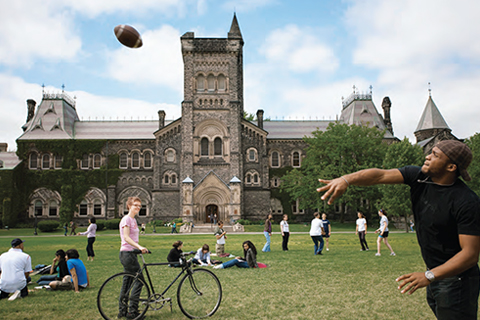David Peterson has no trouble summing up U of T’s progress under the leadership of its 15th president. “It’s a better university after David Naylor’s eight years at the helm,” says the former Ontario premier and U of T chancellor emeritus. Those who’ve worked closely with Naylor agree, emphatically. But they’re all quick to add – perhaps following Naylor’s mantra, without realizing it – that it’s been a team effort.
Richard Nunn, who recently completed his term as chair of U of T’s Governing Council, puts it this way: “David has a passion for excellence that comes through clearly in his leadership and his ability to inspire. The vice-presidents and the broader leadership team really have responded to his vision and have given their best to help realize it.” That vision, says Nunn, has been to strengthen the University of Toronto as “a global university, both in reputation through scholarship and teaching and in the composition of its faculty and students, attracting the best from around the world.”
Peterson captures the sense of momentum of the last several years, reflecting on his involvement as chancellor: “I had the feeling I was part of a great enterprise. U of T has a responsibility to students and the community but also to the country, to be a force for good. David Naylor has led us in fulfilling that responsibility, with great distinction.”
The end of a presidency is an opportunity to take stock. Concrete measurements are necessary, and in these there is much that is encouraging. But Naylor himself would measure U of T’s progress ultimately in terms of the people who make up the university community, their experiences and accomplishments. Accordingly, here follows a triptych of stories to illustrate some of what it means today to be a student, a faculty member, or a graduate of the University of Toronto.
The Student Experience
As a first-year student entering life sciences at U of T, Jelena Savic knew she would have some large classes – and it made her nervous. Like many incoming students, she worried about making new friends and wondered if she’d get a chance to interact with her professors.
Now in her final year of a bachelor of science degree at Victoria College, Savic says her actual U of T experience bore little resemblance to what she had imagined. Yes, she had a few large classes, especially in first year. But through Vic One, one of the U of T programs designed to deliver first-year students a more personal education, she also had two small, seminar-style classes, where she found it easy to meet classmates. “I was able to get to know them, and it was a really impressive group of people,” she says.
Professor David Cook was a driving force in establishing Vic One during his tenure as principal of Victoria. He says support from U of T’s senior administration was crucial in enabling the program to go forward. “I had little doubt that the president would support a proposal for a new way of teaching a portion of our first-year students. Indeed, we embarked on the program because we knew that we would be supported by the president and the provost.”
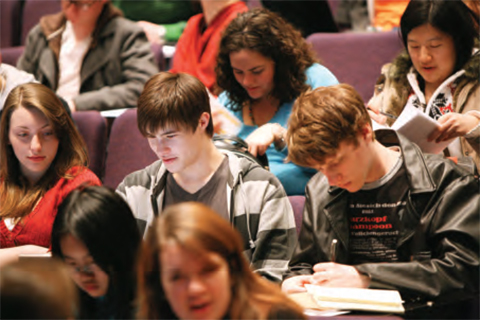
With encouragement and budgetary backing from U of T President Naylor and former provost Cheryl Misak, Vic’s example has been adapted in varied forms by every college on the St. George campus and by U of T Mississauga and U of T Scarborough. Victoria University President Paul Gooch observes that the One model helps “to deliver a personal education, particularly in first year. [It helps] students connect to a community, to learn how to learn, and to develop good habits of research and writing. In a small group you have to speak up, and it makes it difficult to be anonymous.”
At the same time the university increased small-class learning opportunities such as the One programs, it invested heavily on other fronts to transform the undergraduate student experience. It has turned its size to students’ advantage – providing even more opportunities for undergraduates to learn from world-class researchers and emphasizing superb teaching, particularly in the largest classes.
Clare Hasenkampf, a professor of biology at U of T Scarborough and a recipient of the President’s Teaching Award, is familiar with the challenges of teaching in a large lecture hall. With 500 to 1,000 students in each of her introductory biology classes, Hasenkampf finds simple ways to make the room feel smaller: for example, she has students break into groups at regular intervals to solve problems related to her lecture material. But what’s most important, regardless of class size, she says, is for students to understand that they will be able to apply what they’re learning outside the university. “I want students to think of themselves as scientists in training, not students in science courses.”
Hasenkampf belongs to U of T’s Teaching Academy, a group of President’s Teaching Award winners who advocate for best practices and innovation in teaching across the university. The academy reflects a “culture shift at U of T that places a high value on excellent teaching,” according to Carol Rolheiser, director of the university’s Centre for Teaching Support & Innovation and an OISE professor. How does U of T define “excellent teaching?” Rolheiser argues that it must include fostering an understanding of how to connect disparate ideas, how to apply learning, and how to continue learning on one’s own. “I want my students – five, 10, 20 years from now – to see that what they learned at U of T affected them profoundly and in an ongoing way,” she says.
It’s a theme Naylor has emphasized throughout his term, starting with his installation address in 2005. Rolheiser says, “President Naylor’s leadership in launching the President’s Teaching Award in 2006 is one example of his unwavering commitment to excellence in teaching.”
In addition to more small-class options and renewed support for great teaching, the university has worked hard to strengthen undergraduate education in other ways – such as providing more research experiences, internships and study abroad sessions. Samah Rahman recently completed a BA with a double major in sociology and criminology at U of T Mississauga. In third year, she worked with Professor Erik Schneiderhan on a research project she proposed (but which they designed together) – to determine what barriers immigrants to the Toronto area face in adapting to life in Canada. The following year Rahman worked with Schneiderhan on his research, culminating in a trip to England to conduct interviews with visible minority groups. Now considering grad school, Rahman describes these experiences as among the highlights of her university education.
Of course, life outside the classroom is a crucial part of the student experience. Jill Matus, vice-provost, students and first-entry divisions, says that with more than 800 clubs and student-run organizations across the three campuses, there are extra-curricular opportunities that match almost any student’s interests. This fall, U of T launched the cocurricular record, which provides graduates with an official document to track their activities and to complement their academic transcript. Matus points to recent investments in world-class athletics facilities – such as Varsity Centre, the UTSC Aquatics Centre and Field House and UTM’s Recreation, Athletics and Wellness Centre – to better serve the university’s varsity athletes and thousands of faculty, staff and students, both undergraduate and graduate.
The university has also made changes aimed specifically at strengthening the experience of graduate students. Brian Corman, dean of the School of Graduate Studies, says his team has provided increased guidance on graduate supervision for faculty. The school has developed tools for its students, such as workshops on English-language writing and a Graduate Professional Skills program that offers non-credit courses and co-curricular activities. The efforts seem to be paying off : A 2010 survey of almost 5,000 grad students found a high level of satisfaction with their U of T experience; 70 per cent rated it “excellent” or “very good.”
Jasdeep Saggar is one of those satisfied students. She came to U of T from Winnipeg in 2006 to do her master’s in nutritional science because, she says, she was impressed by the variety of programs, the availability of funding for grad students and the quality of research conducted here: “You can find leading experts in whatever field you’re looking for within a few kilometres of the St. George campus.”
Saggar stayed for her PhD – in medical biophysics – not just because she found a supervisor in her field of interest (cancer research). She also appreciated initiatives such as the Graduate Professional Skills program. “The university recognizes that in order for grad students to excel they need to develop skills in such areas as business, communication, networking and giving effective presentations,” she says.
Research and Innovation
Paul Young, U of T’s vice-president of research and innovation, rejects the commonly made distinction between basic and applied research. In his view, research exists along a continuum, and the role of a university is to generate new knowledge at one end and to help find uses for these insights and discoveries through social and technological innovation at the other.
Over the past several years, the University of Toronto has boosted its research enterprise along the entire spectrum, from pure scholarship to market-ready invention. U of T ranks second in the world after Harvard University in the annual number of academic publications produced, and first in Canada in both publications and citations – the latter a measure of the impact of the research being published. With its partner hospitals, U of T now brings in $1.2 billion a year in research funding, up 40 per cent since 2005.
Increasingly, U of T faculty undertake scholarship that is multidisciplinary, collaborative and international, and which brings together researchers from a variety of fields, institutions, companies and countries. “Collaborating with other top-ranked research institutions around the world, including in the private sector, has become a major priority for the university,” says Peter Lewis, associate vice-president of research and innovation, global research partnerships. A prime example: U of T has been involved for several years with the Structural Genomics Consortium, a partnership that has involved leading universities in Sweden and England and that supports the discovery of new medicines through open-access research into human proteins. More recently, U of T has led a consortium of universities collaborating with IBM on a $210-million project to develop data models for improved public services, such as the provision of drinking water, public transit, traffic logistics, health care and energy. These are but two examples of some 8,000 research collaborations between U of T faculty and peers at other universities around the world – in 2012 alone.
When researchers make a discovery, how quickly and effectively it finds its way out of the university is important to society. On this front, U of T is now a continental leader. Between 2009 and 2011, the number of startup companies emerging from U of T almost tripled, putting the university in third place in North America, behind only the Massachusetts Institute of Technology and the University of Utah.
Many observers credit the creation of MaRS in 2001 with catalyzing this transformation. The brainchild of former U of T president John Evans, MaRS rapidly developed 1.5 million square feet of office and laboratory space near the university dedicated to accelerating innovation. MaRS CEO Ilse Treurnicht says, “U of T was there from the very beginning, as part of the planning team and providing critical seed funding earlier than any other institution. The partnership continues to strengthen, with growing impact on the innovation economy of the region and Canada.” Scores of U of T companies have been incubated at MaRS and advised by its startup veterans. Thousands of U of T students now take Entrepreneurship 101 at MaRS, many of them online.
As MaRS expanded, U of T President David Naylor and Treurnicht (who are husband and wife) floated the idea of a new Toronto regional consortium that would bundle great ideas and inventions and bring them to market. Leaders from MaRS, U of T and a core group of partner hospitals developed the concept. Tony Redpath, then MaRS’ vice-president, partner programs, was involved from the beginning. He highlights Naylor’s “vision and leadership” in “convincing 16 academic institutions and research hospitals to work together” in what became known as MaRS Innovation. “His public commitment and persuasive powers led to the rise of what is now acknowledged as the leader in the federal government’s Centres of Excellence for Commercialization and Research program and a completely new approach to academic entrepreneurship,” says Redpath.
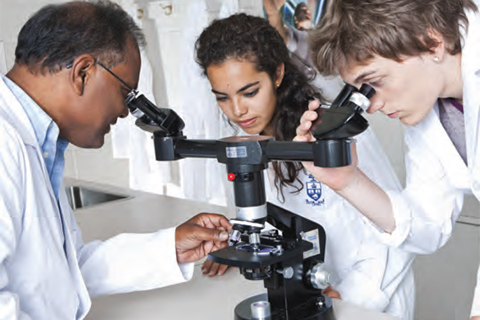
U of T was now in a good position to refocus its own efforts internally. Young and Lewis developed the university’s single, integrated Innovations and Partnerships Office and gave it three objectives: to promote consideration of downstream applications as discoveries occur; to make it easier for investigators to take part in industry-sponsored research as a complement to independent research; and to foster a stronger culture of entrepreneurship among students.
Cast Connex is a good example of what the university has been promoting. The company was co-founded by U of T engineering grad Carlos de Oliveira in 2007, based in part on his master’s thesis. De Oliveira had developed the idea for a new kind of steel joint that could reduce construction costs while also making buildings more earthquake-resistant.
After finishing his thesis, de Oliveira worked with the university’s technology transfer office, which provided crucial mentorship and advice. He and other startups received guidance on everything from applying for government grants to filing patents, and were given workspace, where they often learned from each other. “Sometimes just hearing how someone else spoke with a potential vendor on the phone was instructive,” says de Oliveira. Today, the company’s products are used in structures around the world, among them, the new World Trade Center.
University officials appreciate the benefit to society in harnessing the ideas of 80,000 students, many of whom are technologically adept and entrepreneurial in outlook. Derek Newton, who became executive director of the Innovations and Partnerships Office in 2012, says he has observed a “huge surge” in the number of students involved in invention disclosures – two-thirds now include a student as co-inventor. “In the past, you went to university so you could get a good job at a good company,” he says. “Students still do that, of course, but now we’re doing a lot more to help them create their own job in their own great company.”
Alumni Leadership
In his recent three-year posting in Beijing, David Mulroney (BA 1978 St. Mike’s), Canada’s former ambassador to China, heard tales in many small cities of one of the university’s better-known alumni: Norman Bethune, who performed emergency surgery and provided medical training in China in the 1930s. Mulroney also encountered fellow alum Mark Rowswell (BA 1988 UC), who performs in China under the stage name “Dashan” and is one of the country’s favourite comedians. These were just two ways Mulroney realized U of T’s global reach – and the impact of its alumni – while he was abroad, he says. As ambassador, Mulroney also needed to keep close tabs on Canadian culture and public debate. Many of the most prominent names – Canada’s voices in the world, in a sense – were U of T graduates. “U of T really is connected with the very best of Canadian life,” he observes.
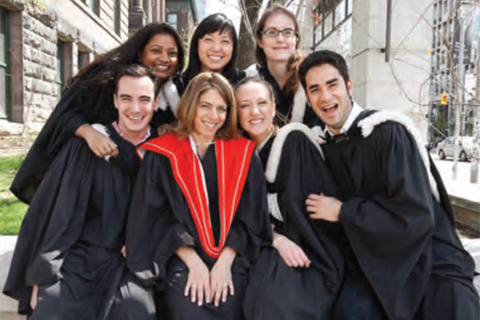
While the university often touts the achievements of its professors and students – and their contributions to research and innovation in Canada – the university’s 525,000 graduates living in more than 180 countries are also making a huge impact around the world. Some have achieved international renown: five Nobel Prize winners are U of T graduates, for instance, including Lester B. Pearson, who was awarded the 1957 Nobel Peace Prize and went on to become Canada’s 14th prime minister. Many others, though not as well known, occupy leadership positions in every field of endeavour.
In recent years, U of T has expanded its efforts to engage alumni, not only in the Toronto area, but increasingly through local and regional networks abroad. “We wish to strengthen our alumni’s sense of connection, and to continue to bring them the best of what the university has to offer, wherever they are,” says Barbara Dick, assistant vice-president, alumni relations.
Paul Cadario (BASc 1973) is one of the university’s most prolific alumni volunteers. The former World Bank executive credits President David Naylor with helping catalyze these new engagement initiatives. “David’s articulate and energetic advocacy for the university, and for public policy to make Ontario and Canada stronger, got alumni worldwide all fired up about U of T. He was an engaging, tireless – and very persuasive – ambassador at alumni events everywhere.” As both the first openly gay president of the U of T Alumni Association and the first to live outside the Toronto region, Cadario emphasized Naylor’s “commitment to inclusion and to expanding the reach of alumni engagement.”
The university is holding more alumni events, and featuring academic speakers at many of them, partly to remind graduates of the university resources that are available to them. At last May’s Spring Reunion – which drew record crowds – the Stress-Free Degree lecture series (featuring professors and alumni), counted as one of the weekend’s most popular programs. “Shaker” events bring together young alumni for career and social networking in a casual setting, while the Next Steps conference allows graduating arts and science students to receive hands-on advice from career experts and fellow alumni.
Many U of T alumni engage with the university by serving as mentors – and even by hosting dinners at their home. For several years now, “Dinner with 12 Strangers” has brought together U of T students, alumni and professors for informal dinner parties. The idea was to make a large campus seem smaller, especially for students. Harvey Botting (BA 1967 VIC, MBA 1985), an alumni governor and former alumni association board member, was an enthusiastic early host; he liked the idea of encouraging interaction among all members of the university community. “It is remarkable how much energy and connectedness comes out of these evenings,” he says.
David Mulroney himself recently returned to campus – as a distinguished senior fellow at the Munk School of Global Affairs. Like many grads who come back to U of T, he has assumed a mentorship role, helping students understand how they might interact with a government partner on an international project. Not surprisingly, he’s also noticed a few changes on campus: “I am absolutely overwhelmed by the buzz – all the new buildings, the activity, the people – it’s electric,” he says. “It’s a great place to return to.”
***
Electric might be a good way to describe the University of Toronto during David Naylor’s eight years as president. Those who know U of T’s 15th president describe him as smart, determined and almost literally indefatigable. “A pragmatic visionary,” is how Jack Petch, chair of the Governing Council during part of Naylor’s term, puts it.
Chancellor Emeritus David Peterson concurs. “I marvelled at his capacity both as a strategist and as a tactician. And he has an absolutely dazzling intellect. With two questions he will go to the heart of any matter. This is a huge, complex organization but he understands what’s going on virtually everywhere.”
Peterson also praised Naylor’s management style, noting that he brings out leadership qualities in others. “David Naylor works extremely well with people, building them up. He has the rare gift of being able to work with difficult people, too. He gets a little testy and you can see smoke coming out of his ears. But he has the capacity to bite his tongue, which does not come naturally to him.”
Rose Patten was chair of the Governing Council in the early years of Naylor’s presidency, and chair of the search committee that recommended his appointment. “We all know David’s brilliance is the starting point for his outstanding leadership,” she says. “But it’s his most rare and powerful combination of humility and resolve that distinguishes him.”
That combination might explain Naylor’s ability both to drive a coherent and comprehensive plan, and to see it realized, through the engagement and leadership of countless others, from the senior administrative team to the staff, faculty, students, alumni, and friends of the University of Toronto.
The Long View and the Big Picture
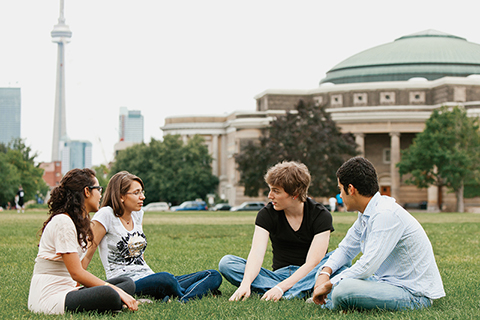
“I have known every president of the University of Toronto since Sidney Smith. I have watched the work of Dr. Naylor in his time as president of the University of Toronto. He has been part of and provided leadership for the changes that are taking place in post-secondary education in this country and elsewhere. He has recognized the need for the University of Toronto to improve the students’ experience as they enter that university. He has been involved with the maturing of both the Scarborough and Mississauga campuses, which institutions have become almost full-fledged universities themselves. He is a man who has shown great leadership, great sensitivity and the intellectual ability to adjust to the changes in the post-secondary system. Dr. Naylor will be missed not just by the University of Toronto, but the education community in a broader sense.”
The Honourable William G. Davis, P.C., C.C., Q.C.
18th Premier of Ontario
Former governor of the University of Toronto
BA, 1951 (UC); LLD, 1967
Recent Posts
U of T’s 197th Birthday Quiz
Test your knowledge of all things U of T in honour of the university’s 197th anniversary on March 15!
Are Cold Plunges Good for You?
Research suggests they are, in three ways
Work Has Changed. So Have the Qualities of Good Leadership
Rapid shifts in everything from technology to employee expectations are pressuring leaders to constantly adapt


